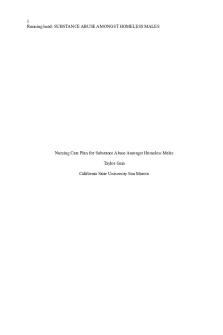Alcohol-Withdrawal- Nursing Care-Plan/ nursing intervention PDF

| Title | Alcohol-Withdrawal- Nursing Care-Plan/ nursing intervention |
|---|---|
| Course | Nursing Process |
| Institution | Los Angeles Valley College |
| Pages | 1 |
| File Size | 93.5 KB |
| File Type | |
| Total Downloads | 20 |
| Total Views | 155 |
Summary
alcohol withdrawal nursing care plan, nursing goals, nursing assessment, nursing outcomes, nursing diagnosis, nursing interventions....
Description
CHAPTER 11Substance Abuse
161
NURSING CARE PLAN 11-1 Patient in Alcohol Withdrawal NURSING DIAGNOSIS Acute confusion related to alcohol abuse and delirium as evidenced by increased agitation, hallucinations, fluctuations in level of consciousness and psychomotor activity, disorientation, or misperceptions.
PATIENT GOALS 1. Demonstrates decrease in alcohol withdrawal severity. 2. Experiences no injury or complications of acute alcohol withdrawal. 3. Experiences no hallucinations. 4. Experiences no seizures.
Outcomes (NOC)
Interventions (NIC) and Rationales
Substance Withdrawal Severity
Substance Use Treatment: Alcohol Withdrawal
• • • • • • • • • • • •
Substance cravings Agitation Hyperreflexia Tremors Change in vital signs Disorientation Altered level of consciousness Difficulty interpreting environmental stimuli Misinterpretation of cues Sleeplessness Hallucinations Seizures
Measurement Scale 1 = Severe 2 = Substantial 3 = Moderate 4 = Mild 5 = None
Asks for validation of reality Reports decrease in hallucinations or delusions Perceives environment accurately Exhibits logical thought flow patterns Exhibits reality-based thinking Exhibits appropriate thought content
Measurement Scale 1 = Never demonstrated 2 = Rarely demonstrated 3 = Sometimes demonstrated 4 = Often demonstrated 5 = Consistently demonstrated
NURSING DIAGNOSIS PATIENT GOALS
Seizure Precautions • Keep suction, Ambu-bag, and oral or nasopharyngeal airway at bedside to establish respiratory function after seizure activity. • Use padded side rails and keep side rails up to prevent injury during seizure activity.
Delirium Management
Distorted Thought Self-Control • • • • • •
• Monitor vital signs during withdrawal to identify extreme autonomic nervous system response. • Administer antiseizure drugs or sedatives to prevent alcohol withdrawal delirium and relieve other symptoms during withdrawal. • Administer vitamin therapy to prevent Wernicke’s syndrome. • Address hallucinations in a therapeutic manner to provide reality orientation. • Determine CIWA-Ar score every 4 hours until it is less than 8 for 24 hours to assess need for medications. • Provide emotional support to patient/family to decrease anxiety.
• Monitor neurologic status on an ongoing basis to determine appropriate interventions. • Verbally acknowledge the patient’s fears and feelings to decrease anxiety. • Provide patient with information about what is happening and what can be expected to occur in the future to assist in reality orientation. • Maintain a well-lit environment that reduces sharp contrasts and shadows to reduce external stimuli. • Remove stimuli, when possible, that create misperception in a particular patient (e.g., pictures on the wall or television) to reduce misinterpretation of environment. • Inform patient of person, place, and time to promote orientation. • Use environmental cues (e.g., signs, pictures, clocks, calendars, and color coding of environment) to stimulate memory, reorient, and promote appropriate behavior.
Ineffective self-health management related to inadequate coping mechanisms and resources as evidenced by abuse of alcohol 1. Acknowledges a substance abuse problem 2. Commits to alcohol cessation 3. Identifies positive coping mechanisms and resources to use during alcohol abstinence
Outcomes (NOC)
Interventions (NIC) and Rationales
Alcohol Abuse Cessation Behavior
Substance Use Treatment
• • • • • • • • •
• Encourage patient to take control over own behavior to change undesired behaviors. • Discuss with patient the impact of substance use on medical condition or general health to promote acknowledgment of consequences of use. • Identify constructive goals with patient to provide alternatives to the use of substances to reduce stress. • Assist patient to learn alternative methods of coping with stress or emotional distress to reduce substance use. • Identify support groups in the community for long-term substance abuse treatment to promote continued abstinence.
Expresses willingness to stop alcohol use Develops effective strategies to eliminate alcohol use Commits to alcohol elimination strategies Uses strategies to cope with withdrawal symptoms Uses effective coping mechanisms Adjusts lifestyle to promote alcohol elimination Obtains assistance from health professional Uses available support groups Eliminates alcohol use
Measurement Scale 1 = Never demonstrated 2 = Rarely demonstrated 3 = Sometimes demonstrated 4 = Often demonstrated 5 = Consistently demonstrated
Copyright © 2014, 2011, 2007, 2004, 2000, 1996, 1992, 1987, 1983 by Mosby, an imprint of Elsevier Inc.
A d di cti ve B eh av i...
Similar Free PDFs

Community nursing careplan 2
- 16 Pages

Nursing Quiz-Nursing process
- 2 Pages

Math - nursing
- 173 Pages

Nursing community
- 12 Pages

Nursing Informatics
- 3 Pages

Nursing Theories
- 64 Pages

Nursing Diagnosis
- 5 Pages

Pharmacology nursing
- 11 Pages

Dabigatran - nursing
- 1 Pages
Popular Institutions
- Tinajero National High School - Annex
- Politeknik Caltex Riau
- Yokohama City University
- SGT University
- University of Al-Qadisiyah
- Divine Word College of Vigan
- Techniek College Rotterdam
- Universidade de Santiago
- Universiti Teknologi MARA Cawangan Johor Kampus Pasir Gudang
- Poltekkes Kemenkes Yogyakarta
- Baguio City National High School
- Colegio san marcos
- preparatoria uno
- Centro de Bachillerato Tecnológico Industrial y de Servicios No. 107
- Dalian Maritime University
- Quang Trung Secondary School
- Colegio Tecnológico en Informática
- Corporación Regional de Educación Superior
- Grupo CEDVA
- Dar Al Uloom University
- Centro de Estudios Preuniversitarios de la Universidad Nacional de Ingeniería
- 上智大学
- Aakash International School, Nuna Majara
- San Felipe Neri Catholic School
- Kang Chiao International School - New Taipei City
- Misamis Occidental National High School
- Institución Educativa Escuela Normal Juan Ladrilleros
- Kolehiyo ng Pantukan
- Batanes State College
- Instituto Continental
- Sekolah Menengah Kejuruan Kesehatan Kaltara (Tarakan)
- Colegio de La Inmaculada Concepcion - Cebu






